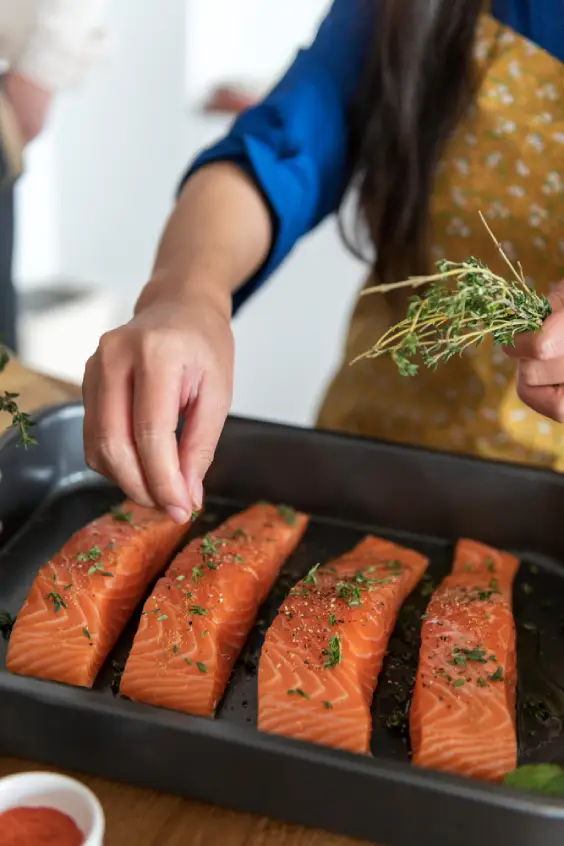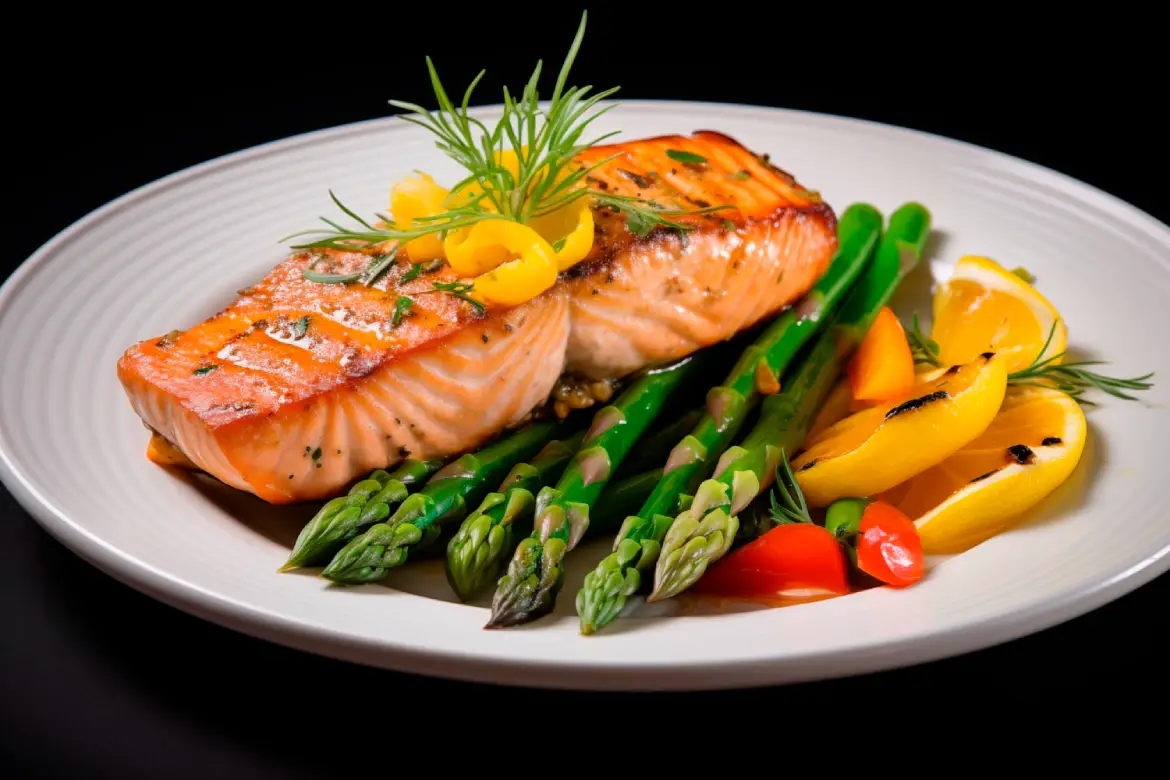In the culinary world, the quest for the perfect dinner often leads us to the ocean’s bounty, with Bake Salmon at 400 taking center stage. Revered not only for its rich flavor but also for its omega-3 fatty acids, salmon is a powerhouse of nutrition that can elevate any meal from mundane to magnificent. Today, we’re diving deep into the art of baking salmon, specifically at the magic temperature of 400°F. This guide will walk you through selecting the best fillet, seasoning it to perfection, and baking it just right, ensuring a moist, flavorful dish every time. So, let’s get started on this culinary journey, where simplicity meets sophistication in the kitchen.
Introduction
The Ultimate Guide to Bake Salmon at 400 Degrees
Ah, salmon! A true gem of the sea, celebrated not just for its delightful taste but also for its myriad health benefits. It’s a dish that promises not just a feast for the taste buds but a boost for your health too. And when it comes to cooking salmon, baking it at 400°F emerges as a foolproof method that guarantees a perfectly cooked, succulent meal every single time.
But why 400°F
you might wonder? Well, this temperature is the sweet spot that ensures your salmon is cooked through without drying out, locking in all its natural flavors and nutrients. Plus, it’s a breeze to prepare, making it an ideal choice for both weeknight dinners and special occasions. Whether you’re a seasoned chef or a kitchen newbie, mastering the art of baking salmon at this temperature will elevate your culinary game.
In this guide
we’ll explore everything you need to know about baking salmon at 400°F. From selecting the perfect salmon fillet to seasoning it with just the right herbs and spices, we’ve got you covered. We’ll also share some pro tips on how to achieve that perfectly tender, flaky texture that makes salmon so irresistible. So, preheat your ovens, and let’s embark on this delicious adventure together!
How Long to Bake Salmon at 400 without Foil
Baking salmon at 400°F without foil is a splendid way to achieve a deliciously moist and flavorful fillet with a slightly crisp exterior. This method allows the heat to directly envelop the salmon, creating a beautifully textured dish that’s both healthy and satisfying. Here’s how to do it:
Preparation Steps:
- Preheat Your Oven: Start by preheating your oven to 400°F (204°C). This ensures that your salmon cooks evenly and gets that perfect finish.
- Choose Your Salmon Wisely: Opt for fresh or fully thawed salmon fillets. Look for fillets that are about 1 to 1.5 inches thick for optimal cooking.
- Prepare the Baking Sheet: Instead of foil, use a baking sheet lined with parchment paper. This not only prevents sticking but also makes cleanup a breeze.
- Pat the Salmon Dry: Use paper towels to gently pat the salmon dry. This step is crucial for achieving that slightly crisp exterior.
Seasoning Your Salmon:
- Oil It Up: Lightly brush your salmon fillet with olive oil. This adds moisture and helps the seasoning stick to the fish.
- Season Generously: Season your salmon with salt, pepper, and your choice of herbs or spices. Consider a sprinkle of garlic powder, a touch of lemon zest, or a dash of dill for a flavor boost.
Baking Time:
- Thickness Matters: The key to perfectly baked salmon is to consider the thickness of your fillets. As a general rule, bake your salmon for 4-6 minutes per half-inch of thickness. For a standard fillet that’s about an inch thick, you’re looking at approximately 10-12 minutes in the oven.
- Check for Doneness: The best way to ensure your salmon is perfectly cooked is to check its internal temperature. The ideal temperature for salmon is 145°F (63°C) when measured at the thickest part of the fillet. If you don’t have a thermometer, look for opaque flesh that flakes easily with a fork.
Serving Your Salmon:
Once your salmon is beautifully baked, let it rest for a few minutes before serving. This allows the juices to redistribute, ensuring each bite is as delicious as the last. Serve your salmon with a side of roasted vegetables or a fresh salad for a complete meal.

Do you bake salmon at 350 or 400?
When it comes to baking salmon, the choice between 350°F and 400°F largely depends on your personal preference, the specific recipe you’re following, and the texture you desire for your salmon. Both temperatures can yield delicious results, but there are distinct differences in the outcome of the salmon’s texture and cooking time.
Baking Salmon at 350°F
Baking salmon at 350°F is a gentler cooking method that results in a moist, tender texture. This lower temperature is ideal for slow-roasting, allowing the salmon to cook evenly throughout without the risk of drying out. It’s perfect for when you have a bit more time and want to ensure the fish remains especially juicy and tender. The cooking time at 350°F will be slightly longer than at 400°F, typically ranging from 20 to 25 minutes, depending on the thickness of the fillet. This method is great for recipes that include a marinade or sauce, as the lower temperature allows the salmon to absorb more flavors during cooking.
Bake Salmon at 400 °F
Baking salmon at 400°F is a quicker method that still ensures the salmon is cooked through while also providing a slightly firmer texture. The higher temperature creates a slightly crisp exterior while keeping the inside moist and flaky. This method is ideal for those who prefer a bit of a crust on their salmon or are short on time. Typically, a salmon fillet will take about 10 to 15 minutes to bake at 400°F, making it a speedy option for a weeknight dinner. It’s also the better choice for cooking salmon without additional sauces or marinades, as it highlights the fish’s natural flavors and allows for a beautiful finish.
Making the Choice
Ultimately, the choice between baking salmon at 350°F or 400°F depends on your specific needs:
- For a tender, slow-roasted texture and more flavor absorption: Opt for 350°F.
- For a quicker cook time and a slightly crisp exterior: Go with 400°F.
Both temperatures can produce delicious salmon when cooked properly. Consider your desired outcome and the specifics of your recipe when making your choice.
If you are looking for similar recipes, here’s a few of our favorites.
Salmon Baked at 400
Baking salmon at 400°F is a popular and efficient method to achieve a deliciously moist interior with a perfectly tender flake, complemented by a delightful hint of crispiness on the outside. This method strikes an excellent balance between speed and quality, making it an ideal choice for both weeknight dinners and special occasions. Here’s how to master the art of baking salmon at this optimal temperature.
Ingredients and Preparation
Before you begin, ensure you have the following:
- Salmon Fillets: Choose fresh or thawed salmon fillets, preferably about 1 to 1.5 inches thick. Skin-on or skinless works based on personal preference.
- Olive Oil: A light brush of olive oil enhances the salmon’s natural flavors and helps the seasoning adhere to the fish.
- Seasonings: Salt and pepper are essentials. Feel free to add garlic powder, lemon slices, dill, or any other preferred herbs and spices to tailor the flavor to your liking.
Preparation Steps
- Preheat the Oven: Start by preheating your oven to 400°F. This ensures that the salmon cooks evenly from the moment it enters the oven.
- Prepare the Salmon: If your salmon has skin, decide whether you want it skin-side down or up. Most prefer skin-side down for easier eating. Pat the salmon dry with paper towels, brush it lightly with olive oil, and then season as desired.
- Baking Sheet: Line a baking sheet with parchment paper for easy cleanup. Place the salmon on the sheet, ensuring enough space between each fillet for even cooking.
Baking Time
- The general rule of thumb for baking salmon at 400°F is 4-6 minutes per half-inch of thickness. Therefore, a typical fillet, which is about an inch thick, should be perfectly cooked after 10-15 minutes in the oven.
- It’s crucial not to overcook the salmon to maintain its moist interior. The salmon should be opaque and flake easily with a fork when it’s done.
Checking for Doneness
- The most accurate way to check if salmon is cooked is by using an instant-read thermometer. The ideal internal temperature for salmon is 145°F when inserted into the thickest part of the fillet.
- Another method is to check if the salmon flakes easily with a fork. The flesh should separate without resistance, indicating it’s ready to be enjoyed.
Serving Suggestions
Once your salmon is baked to perfection, let it rest for a couple of minutes before serving. This brief rest period allows the juices to redistribute, ensuring every bite is as flavorful as possible. Serve your salmon with a side of roasted vegetables, a fresh salad, or atop a bed of quinoa or rice for a well-rounded meal.

RECIPES
How Long to Bake Salmon at 400
Ingredients:
- 4 salmon fillets (6 ounces each)
- 2 tablespoons olive oil
- Salt and freshly ground black pepper, to taste
- 1 lemon, thinly sliced
- 2 tablespoons fresh dill, chopped (or herbs of your choice such as parsley or thyme)
- 2 garlic cloves, minced
- 1 tablespoon honey (optional for a sweet glaze)
Instructions:
- Preheat the Oven: Begin by preheating your oven to 400°F (200°C). This ensures that the oven is at the right temperature for baking the salmon evenly.
- Prepare the Salmon: If your salmon fillets have any pin bones, remove them with tweezers. Pat the salmon dry with paper towels to remove any excess moisture. This helps in getting a nice texture on the surface.
- Season: Place the salmon fillets on a baking sheet lined with parchment paper for easy cleanup. Brush each fillet with olive oil and season generously with salt and pepper. If you’re using honey, mix it with the olive oil before brushing it on the salmon for a sweet glaze.
- Add Flavor: Place thin slices of lemon on top of each fillet. Sprinkle the minced garlic and chopped dill (or your chosen herbs) over the salmon. The lemon and herbs will infuse the salmon with fresh flavors as it bakes.
- Bake: Transfer the baking sheet to the preheated oven. Bake the salmon for about 12-15 minutes, or until the salmon is cooked through and flakes easily with a fork. The exact time will depend on the thickness of your fillets.
- Check for Doneness: The best way to ensure your salmon is perfectly cooked is to check the internal temperature with an instant-read thermometer. The FDA recommends an internal temperature of 145°F (63°C) for fish.
- Serve: Once done, remove the salmon from the oven and let it rest for a couple of minutes. This allows the juices to redistribute, making every bite succulent. Serve the baked salmon with a side of your choice, such as roasted vegetables or a fresh salad.
FAQs
How long does it take to cook salmon at 400?
Is it better to bake salmon at 350 or 400?
What temperature and length to cook salmon?
How do I know when salmon is done baking?


1 thought on “How Long to Bake Salmon at 400”